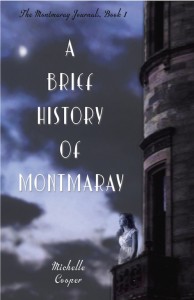If I were a Sensible YA Author, I’d stay well away from Goodreads reviews of my books. After all, reviews aren’t for authors; they’re for readers. Of course, I’m not a Sensible YA Author (if I was, I’d be writing about zombie mermaids, not 1930s politics), so I do occasionally visit Goodreads, where I get to read one-star reviews like this [warnings for plot spoilers and homophobia]:
“The story was interesting and engaging until the end when the author suggests the boys are lovers. WHY? For a young adult book–or any for that matter? Too bad Ms Cooper ruined the book.”
That was the entire review – and that’s a very polite, positive and coherent review, compared to some of them.
But then, there are also Goodreads reviews that are critical, yet thoughtful and entertaining, such as this one of A Brief History of Montmaray, which begins:
“Michelle Cooper is the Quentin Tarantino of young adult novels.”
Um . . . what? It turns out the reviewer isn’t referring to the gory murders in the book, but to Tarantino’s habit of wearing his influences on his sleeve. The review consists largely of complaints about the characters and the plot, but it’s smart and passionate and, most importantly, uses LOLcats to illustrate its points. I loved it.
Then the same reviewer tackles The FitzOsbornes in Exile:
“Dear sir or friend,
I am a princess in exile. My family cannot access our funds unless you, a kind American, will launder money through your bank account and send letterhead, bank statements and personal documents. Thank you for helping.Sincerely,
the FitzOsbournesI don’t know why they didn’t just send out a letter like this, if they needed money so bad . . .”
The review goes on to compare the plot of The FitzOsbornes in Exile to that of the recent X-Men film, and regards Simon as the Clark Gable of Montmaray. It’s absolutely hilarious. Thank you, Mariel, you made my day. Well, my morning, at least. Or part of my morning.
Now, to slightly more serious matters. Here is my blog’s Spam of the Month:
“Dude, you should be a writer. Your article is really interesting. You should do it for a living.”
Okay then, I will! Unfortunately, I’m finding ‘writing for a living’ a bit busy at the moment, so my poor blog has been neglected this month. However, in a few weeks, I will (hopefully) have handed over the manuscript of Montmaray Three (currently known as The NeverEnding Story) to my long-suffering and infinitely patient editor. Then I’ll return to my irregular – but slightly more frequent – blog posting.
In the meantime, just talk quietly amongst yourselves.




